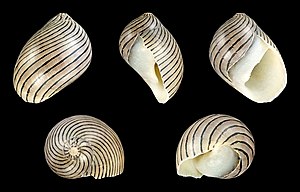Vittina coromandeliana
| Vittina coromandeliana | ||||||||||||
|---|---|---|---|---|---|---|---|---|---|---|---|---|

Vittina coromandeliana |
||||||||||||
| Systematics | ||||||||||||
|
||||||||||||
| Scientific name | ||||||||||||
| Vittina coromandeliana | ||||||||||||
| ( Sowerby , 1836) |
Vittina coromandeliana , in aquaristic circles z. Sometimes also known as the zebra snail , it is a snail from the family of the barn snails (Neritidae) that lives in fresh and brackish water andbelongs to the order of the Neritomorpha . It is widespread in Southeast Asia, the species epithet probably incorrectly refers to the Coromandel coast in South India, since the species does not occur there today.
features
The egg-shaped-conical casing of the Vittina coromandeliana is up to 20 to 24 mm high and reaches a diameter of 18 to 23 mm (15 mm high and 13 mm in diameter). It is apically truncated conical; the apex itself is bluntly rounded and often already corroded. The surface is smooth and shiny. The species shows considerable variability in coloration and color pattern in its large area of distribution. The housing is usually brown or black with yellow zigzag stripes running axially. The mouth is very large, sloping and semicircular. The parietal wall is gray-white to white, smooth and shiny. There is a fine dentition (6 to 10 denticles) in the center of the spindle fold. The outer lip is relatively thin. The operculum is smooth and gray-brown, off-white or yellow-brown, often with an orange border. Inside it is brown-brown to orange in color.
Geographical distribution and habitat
The distribution area of Vittina corommandeliana extends from Thailand, the Malay Peninsula over Indonesia to Polynesia and the Philippines. The occurrence of the species in South India is very doubtful, despite the name. Safe occurrences are not known.
They predominantly colonize standing brackish water basins in the mangrove swamps and the small brackish drainage channels to the open sea. In Malaysia, they have been observed on sunken trunks of nipa palms . They also colonize the estuary areas of small rivers.
Way of life
Like all Neritidae, Neritina coromandeliana is separate sexes. The male has a penis for the transmission of sperm , fertilization takes place in the body of the female. However, they do not multiply in fresh water. The larvae need sea water to develop. After the eggs have been laid, free-swimming larvae, so-called Veliger, hatch from the deposited capsules . These larvae live floating in the sea and feed on protozoa. Only after some time do they transform into crawling and wired snails. Neritidae are therefore dependent on the proximity of the ocean
Taxonomy and systematics
The taxon (as Neritina coromandeliana ) was first published by George Brettingham Sowerby in the work "Conchological Illustrations", which appeared in 200 separate deliveries from 1832 to 1841 (genus Neritina , Fig. 52). For the exact publication date of the taxon, the publication date of the delivery in which Neritina coromandeliana was published must therefore be determined . According to Shaw (1909) this delivery was published in June 1836. The often given publication date 1832 is therefore incorrect. George Brettingham Sowerby gives the Coromandel Coast in India as the type locality. According to Brandt (1974), however, this is probably an erroneous statement, as the species has not yet been found there.
The systematic position of the species is still controversial; the name appears in the publications of the last decades in the combinations Neritina (Vittoida) coromandeliana , Neritina (Provittoida) coromandeliana and Vittina coromandeliana as well as in the original combination Neritina coromandeliana . In the more recent preliminary checklist of the Singapore molluscs, Siong Kiat Tan and Henrietta PM Woo again use Vittina coromandeliana .
The "zebras" on the market are mostly identified as Neritina turrita (Gmelin, 1791) in more recent studies .
supporting documents
Individual evidence
- ↑ a b c Brandt (1974: p. 15)
- ↑ a b c d Siong Kiat Tan and Reuben Clements: Taxonomy and Distribution of the Neritidae (Mollusca: Gastropoda) in Singapore. Zoological Studies , 47 (4): 481-494, 2008 PDF
- ↑ Oliver Zompro & Ingo Fritzsche : Mollusks in fresh and brackish water aquariums. Part I: Schnecken , Arthropoda 16 (2) August 2008, Sungaya-Verlag Kiel. ISSN 0943-7274
- ^ Georg Brettingham Sowerby II: The Conchological Illustrations. London 1832-41. Online at Archive.org (Fig. 52)
- ^ HON Shaw: On the dates of issue of Sowerby's "Conchological Illustrations" from the copy preserved in the Radcliffe Library, Oxford. Proceedings of the Malacological Society of London, 8: 333-340; London PDF
- ↑ FJ Springsteen and FM Leobrera: Shells of the Philippines. 376 pp., Philippines, Carfel B. Leobrera, 1986 ISBN 971-91029-0-X (as Neritina (Provittoida) coromandeliana )
- ^ C. Swennen: The molluscs of the southern Gulf of Thailand. 210 p., Biodiversity Research and Training Program, 2001 (as Vittina coromandeliana )
- ^ Siong Kiat Tan and Henrietta PM Woo: A preliminary checklist of the molluscs of Singapore. Raffles Museum of Biodiversity Research National University of Singapore, Singapore 2010 PDF
- ↑ Chris Lukhaup and Alexandra Behrendt: Snails for the aquarium. 64 pp., Munich, Gräfe and Unzer, 2009 ISBN 978-3-8338-1521-8
- ↑ Fish species data sheet zebra cone PDF
literature
Rolf AM Brandt: The non-marine aquatic Mollusca of Thailand. Archive for Molluscology, 105: 1-423, Frankfurt / M. 1974
annotation
- ↑ According to a more recent aquarium work, the so-called zebra snail is said to be the Neritina turrita , which also lives in Southeast Asia . Another species popular with aquarists is the Neritina natalensis found in East Africa . Hence the scientific name is preferred.
